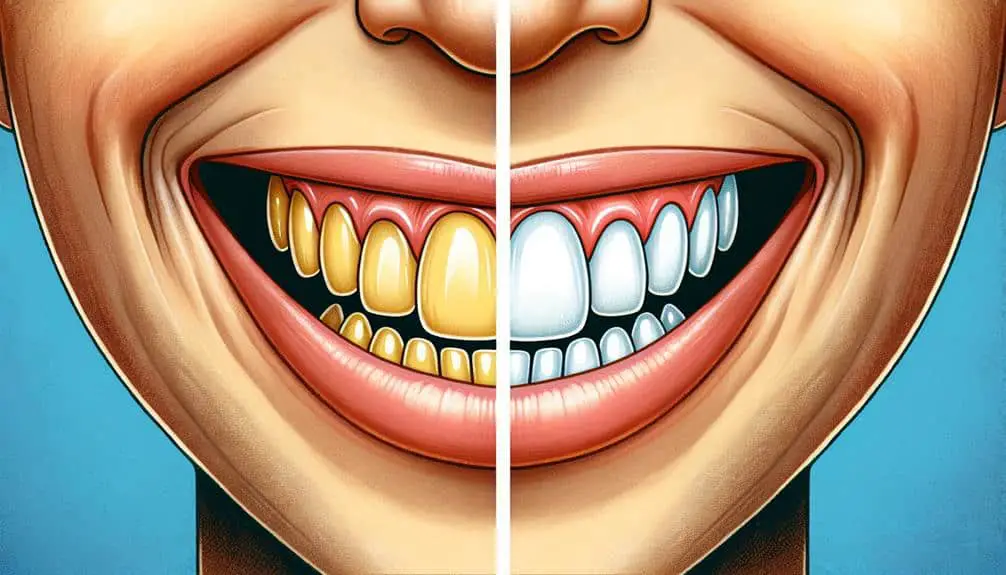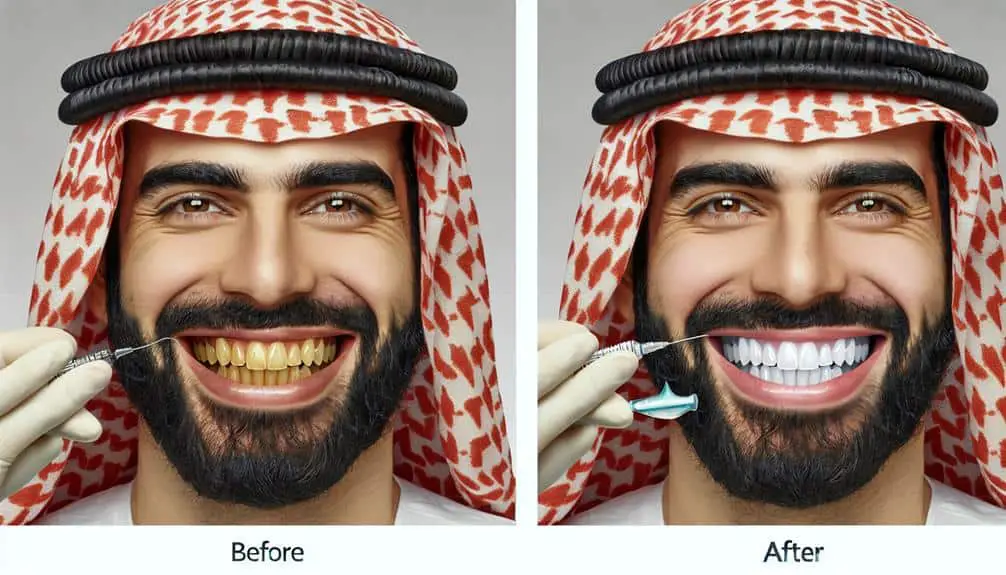Teeth whitening methods effectively target tetracycline stains by breaking down deeply embedded discoloration using bleaching agents like hydrogen peroxide. The chemical reactions within these treatments help to oxidize and reduce the molecules causing the stains, ultimately disrupting the bonds holding them for a whiter smile. Understanding this mechanism is essential for choosing the right whitening approach. For more details on different whitening methods, professional vs. at-home options, and considerations for tetracycline stains, explore further to make informed decisions about your oral health.
Key Points
- Bleaching agents break down tetracycline molecules in enamel and dentin layers.
- Chemical reactions disrupt stain bonds, allowing whitening effects.
- Oxidation and reduction processes target and remove discolored molecules.
- Whitening methods focus on breaking down deeply embedded tetracycline stains.
- Understanding mechanisms aids in selecting effective whitening treatments.
Understanding Tetracycline Stains and Whitening
If you have teeth stained by tetracycline, understanding the nature of these stains and how whitening treatments work is essential for achieving successful results. Tetracycline stains are particularly challenging due to their deep penetration into the enamel and dentin layers of the teeth. These stains occur when tetracycline antibiotics are incorporated into the tooth structure during tooth development, causing discoloration that's difficult to remove through regular brushing or cleaning.
Chemical reactions play a vital role in the whitening of tetracycline stains. Whitening treatments utilize bleaching agents such as hydrogen peroxide or carbamide peroxide to break down the chemical bonds that hold the stain molecules together. This process helps to oxidize and lighten the stains, ultimately leading to a brighter smile.
Understanding the mechanisms behind stain penetration and the chemical reactions involved in whitening treatments is fundamental for choosing the most effective approach to address tetracycline stains. By grasping these concepts, you can make informed decisions about the best whitening methods to achieve the most favorable results.
Mechanism Behind Teeth Whitening for Stains
To understand the effectiveness of teeth whitening for tetracycline stains, it's essential to comprehend the underlying chemical processes that drive the whitening treatment's mechanism. When dealing with tetracycline stains, the discoloration occurs deep within the tooth structure. Bleaching agents used in teeth whitening treatments penetrate the enamel and target the discolored molecules through chemical reactions. These bleaching agents, often containing hydrogen peroxide or carbamide peroxide, break down the chromophores responsible for the stain's appearance.
The chemical reactions initiated by the bleaching agents help to oxidize and reduce the molecules causing the discoloration, leading to a whitening effect. Through this process, the bonds holding the stain molecules together are disrupted, allowing them to be broken down and eliminated. It's essential to follow the recommended treatment protocols to guarantee that the bleaching agents have sufficient time to interact with the stains effectively. Understanding the mechanism behind teeth whitening for tetracycline stains empowers individuals to make informed decisions regarding their oral health and aesthetic goals.
Types of Whitening Methods for Tetracycline Stains
Various whitening methods can effectively address tetracycline stains on teeth, offering individuals options to enhance their smile and confidence.
When dealing with tetracycline stains, some people opt for natural remedies such as baking soda or activated charcoal. These methods are believed to help remove surface stains and brighten teeth, but their effectiveness for tetracycline stains may vary.
DIY solutions like hydrogen peroxide-based whitening kits or whitening strips are also popular choices. These at-home options can be convenient and cost-effective, providing a way to improve the appearance of teeth affected by tetracycline stains.
While these methods may show some improvement, it's important to note that professional whitening treatments performed by a dentist often yield more significant results.
Understanding the various whitening methods available for tetracycline stains can help you make an informed decision on how to best address this type of discoloration and achieve a brighter, whiter smile.
Professional Vs. At-Home Whitening Options
When considering options for whitening tetracycline stains on your teeth, comparing professional treatments with at-home methods is essential to determine the most effective approach for achieving a whiter smile.
- Cost Comparison: Professional whitening treatments tend to be more expensive upfront compared to at-home kits. However, take into account the potential need for multiple at-home kits to achieve similar results to one professional treatment.
- Time Commitment: Professional whitening sessions are often quicker, providing immediate results in just one or two appointments. On the other hand, at-home methods require consistent application over several weeks to see noticeable changes.
- Effectiveness: Professional treatments, due to the higher concentration of whitening agents and the supervision of a dentist, may yield faster and more dramatic results compared to at-home kits, which have lower concentrations of whitening agents.
Considerations and Results for Tetracycline Stains
Given the challenges presented by tetracycline stains on teeth, it's essential to understand the factors that influence the effectiveness of whitening treatments for best results. When it comes to treating tetracycline stains, it's vital to recognize that the effectiveness of whitening methods may vary based on the severity of the stains. While professional treatments like laser whitening or custom trays can provide significant improvements, at-home whitening kits may not deliver the same level of results due to the depth of these stains.
It is important to manage expectations regarding the limitations of whitening treatments for tetracycline stains. Complete removal of these deep-rooted stains may not be achievable with whitening alone. Long-term results and maintenance are also key considerations. Even after successful whitening, tetracycline stains can gradually reappear, necessitating ongoing care to preserve the whiteness of your teeth.
To maintain the results of whitening treatments for tetracycline stains, regular follow-ups with your dentist, good oral hygiene practices, and possibly periodic touch-up treatments are recommended. Understanding these factors can help you make informed decisions about the most suitable whitening approach for your specific tetracycline stains.
Frequently Asked Questions
Can Tetracycline Stains Be Completely Removed With Teeth Whitening Methods?
Teeth whitening methods can greatly lighten tetracycline stains, but complete removal may be challenging. Consider alternative treatments for better success rates. Compare costs and explore home remedies for supplemental improvement.
Are There Any Long-Term Side Effects of Using Teeth Whitening Methods for Tetracycline Stains?
When considering teeth whitening methods for tetracycline stains, it's important to be aware of potential long-term effects. Risks include tooth sensitivity and gum irritation. Safety precautions such as consulting a dentist can help mitigate these concerns.
How Often Should Tetracycline Stain Patients Undergo Whitening Treatments to Maintain Results?
To maintain results for tetracycline stains, consider whitening treatments every 6-12 months. Your dedication to regular sessions and following maintenance tips like avoiding staining foods can prolong the outcome and enhance your smile longevity.
Are There Any Dietary Restrictions or Habits to Avoid to Prevent Tetracycline Stains From Worsening After Whitening?
To prevent tetracycline stains from worsening after whitening, consider lifestyle changes. Avoid foods and drinks that stain teeth, like coffee and red wine. Practice good oral hygiene and visit your dentist regularly for preventative measures.
Can Teeth Whitening Methods for Tetracycline Stains Affect Other Dental Work, Such as Fillings or Crowns?
For best outcomes, consult your dentist to confirm teeth whitening methods for tetracycline stains are compatible with fillings and crowns. Consider stain recurrence, treatment frequency, filling compatibility, and crown durability to maintain dental work integrity.



